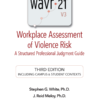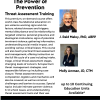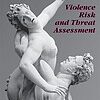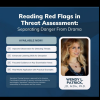Assessing and Managing Violence Risk in Juveniles and Young Adults
Violence on high school and college campuses by teens and young adults has concerned us all. As a result, professionals from a wide range of disciplines – including education, law enforcement, juvenile justice, child advocacy and mental health, need to become equipped with the state of the art knowledge regarding how to assess juveniles and young adults who have come to our attention because of inappropriate statements or threatening behavior. Professionals need a systemic, thoughtful and research based model that provides the best results, allowing high risk youth to be identified along with an effective plan to manage their risk.
This one day workshop, presented by the co-author of Assessing and Managing Violence Risk in Juveniles, addresses these important issues. Recent trends in youth violence will be summarized and two decades of research on violence risk factors will be distilled. Principles for conducting an effective, developmentally informed risk assessment of youth, including the use of structured assessment instruments will be highlighted. Special attention will be given to understanding general violence risk as opposed to targeted violence. This training will help participants understand current best practices as well as empirically based treatments that reduce the risk of youth and young adult violence.
Workshop Content
How Child and Adolescent Development relates to Violence Risk
Types of Aggression in Youth
Risk Factors for Violence in Adolescents and Young Adults
Understanding and Assessing “Psychopathic Traits” in Youth and Young Adults
Contrasting Risk Assessment vs. Violence Prediction
Major Principles for Effective Risk Assessment
Effective Threat Assessment
Current Approaches to Assess Risk for Targeted Violence
Principles for Conducting an Effective Threat Assessment
Effective Treatments to reduce Violence Risk
Workshop Objectives
Describe how normal child and adolescent development may contribute to violence risk
List five risk factors for violence in adolescents
Discuss the differences between risk assessment and violence prediction
Identify three principals for effective risk assessment
Describe the optimal methods of treating potentially violent youth





